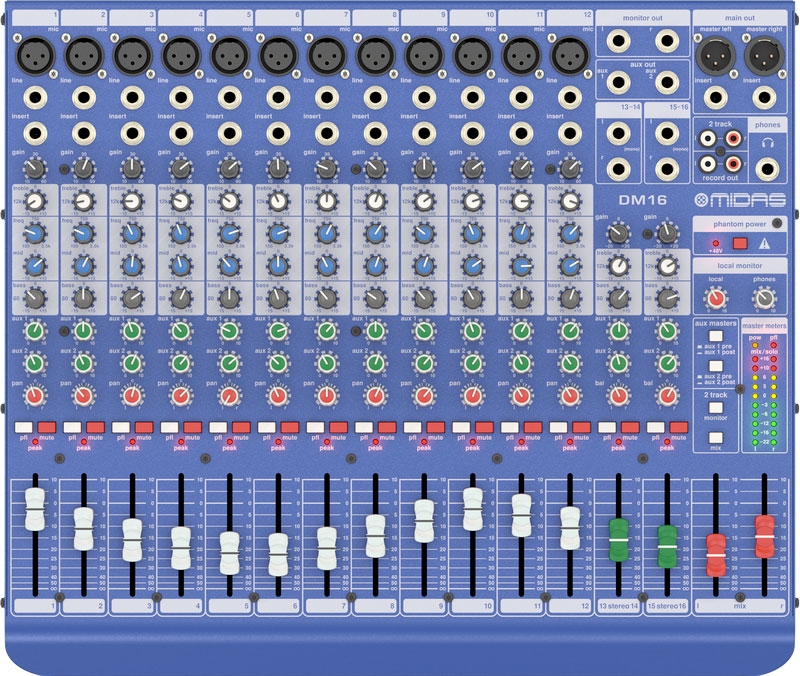The DM16 has 16 inputs, analogue design, suitable for use in live performance and studio recording with 12 MIDAS microphone preamplifiers
The compact DM16 honours your stage or studio desktop space, while providing incredible sonic performance, amazing versatility - and an unheard of level of affordability.
Live Performance and Studio Recording
With 16 channels, the DM16 has more than enough microphone and line inputs to manage a small band or worship team with channels to spare - both on the stage and in the studio. It is also the ideal choice for use as a keyboard or drum sub-mixer for larger scale performances.
Dedicated Stereo Inputs
Line channels 13/14 - 15/16 are dedicated stereo channels, making them ideal for stereo instruments, such as keyboards - and can also be used for mono signals thanks to a convenient balance control on each 2-channel grouping. These channels can also be used as return inputs for signals sent external effects processing equipment.
Sublimely Musical British EQ
The British consoles of the 1960s and '70s changed the sound of rock and roll - without them the British Invasion might not have happened. Those legendary mixing desks soon became the envy of engineers and producers all over the world. The 3-band channel EQ on our DM16 mixers is based on that very same circuitry, allowing you to imbue signals with incredible warmth and detailed musical character. The sweepable mid-frequency band provides a broad tonal palette with which to finetune the ideal signal. Even when applied generously, these equalizers exhibit sweet forgiveness and superb audio quality.
Dual Aux Sends
The DM16 is also equipped with 2 aux sends with pre/post fader switching for added versatility. Users can select to use them for external effects processing, custom monitor mixes, or a combination of the two. Additional monitoring outputs are provided of the main mix for stage or studio monitor applications.
Classic Precision
All of DM16 mixer's 60 mm faders have been carefully designed to provide a long life of highly precise level setting, ensuring repeatable and flawless performance for many years to come.
Quality is Job #1
While some manufacturers cut quality when they design small mixers, we understand that every mixer should provide uncompromising performance and a robust feature set. The very embodiment of quality, from its rugged construction and top-of-the-range components to that unmistakable MIDAS sound - the DM16 is a truly professional audio console.
Value
No matter what your audio mixing needs, the DM16 provides the performance and features required to take your talent to the next level, at a price that is custom-tailored for the budget-savvy user. Professional sound quality, our legendary MIDAS mic preamps, 3-band EQs with sweepable mids, and much more make the DM16 mixer ideal for both your live gigs and recording. Try one out today, or feel free to order yours online.
